Sure! Here’s the translation:
—
The rivalry with the United States marks a new phase: more state investment, independent infrastructure, and energy leadership to power AI data centers.
China is set to deploy up to $98 billion in artificial intelligence (AI) investments by 2025, according to a new report from Bank of America, representing a 48% growth from the previous year. This figure reinforces Beijing’s strategy to compete with the U.S. in the 21st-century technological race.
The difference is clear: while the United States prioritizes the development of advanced chips and AI hardware, China opts for massive investments in infrastructure, data centers, and green energy, in addition to directly supporting its tech giants from the public sector.
AI as a driver of technological sovereignty
Of the estimated total, $56 billion will come from public funds, and an additional $24 billion from major Chinese tech companies like Alibaba, Tencent, and ByteDance. Contributions are also expected from telecommunications operators and special state bonds aimed at supporting digital infrastructure.
“China is leveraging one of its main strengths: long-term state planning,” explains Matty Zhao, co-director of analysis at Bank of America Securities, in statements to the South China Morning Post. “With the U.S. chip blockade, the government has responded in the area where it knows best: structural investment.”
DeepSeek: the trigger for a new wave of investment
Enthusiasm surrounding AI in China has particularly surged following the success of DeepSeek, a Hangzhou-based startup that surprised the world with generative language models like V3 and R1, developed at significantly lower costs and energy consumption than the major Western LLMs. This milestone has demonstrated that efficiency can be as decisive as power.
The effect was immediate. Alibaba announced in February a $53 billion investment in AI infrastructure over three years, and Tencent quadrupled its spending in the fourth quarter of 2024, reaching $5.1 billion.
A different strategy: fewer chips, more data centers and energy
Unlike the U.S., where investment is more tied to the development of semiconductors and accelerators like those from NVIDIA, China focuses on building a network of data centers and bolstering its energy capacity to sustain the AI boom.
Beijing recently published an action plan to coordinate the deployment of data centers alongside clean energy, ensuring the necessary electricity supply for training and executing advanced models.
According to Bank of America, copper and electrical equipment consumption is expected to increase at a rate of 20% annually until 2030, while liquid cooling solutions, essential for cooling AI chips, could grow by as much as 57% annually this year alone.
Huawei and the race for indigenous chips
Although U.S. sanctions prevent China from accessing next-generation chips like NVIDIA’s H100, the country continues to expand its local capabilities. Huawei, along with other firms backed by the state fund Big Fund III, is working to develop its own alternatives in lithography and EDA software, the two Achilles’ heels of the Chinese industry.
The U.S. is not falling behind: Stargate and Trump on campaign mode
In the face of the Chinese offensive, Donald Trump has launched his “Stargate Project”, which envisions up to $500 billion in AI infrastructure over four years. This includes new power plants, regulatory reforms to expedite permits, and the use of federal lands, including Pentagon properties, to build data centers.
Trump plans to present a report on July 23 detailing all the measures, under the symbolic title of “AI Action Day,” with a speech scheduled for July 15 in Pennsylvania.
Who will lead global AI?
In this race, not only technological supremacy is at stake, but also energy capacity, digital sovereignty, and the innovation model that will shape the coming decades.
- The U.S. bets on market efficiency, private ownership, and supremacy in hardware.
- China opts for energy self-sufficiency, state control, and rapid expansion of critical infrastructure.
Both models have strengths and weaknesses. China still depends on imported chips, but is moving quickly to address that gap. The U.S. leads in semiconductors but faces energy tensions and reliance on external suppliers for physical expansion.
What is indisputable is that the battle for artificial intelligence has ceased to be theoretical. It is now materializing in miles of fiber, tons of copper, blocks of silicon, and power plants spread across the globe.
And meanwhile, the clock is ticking.
Source: techwireasia

